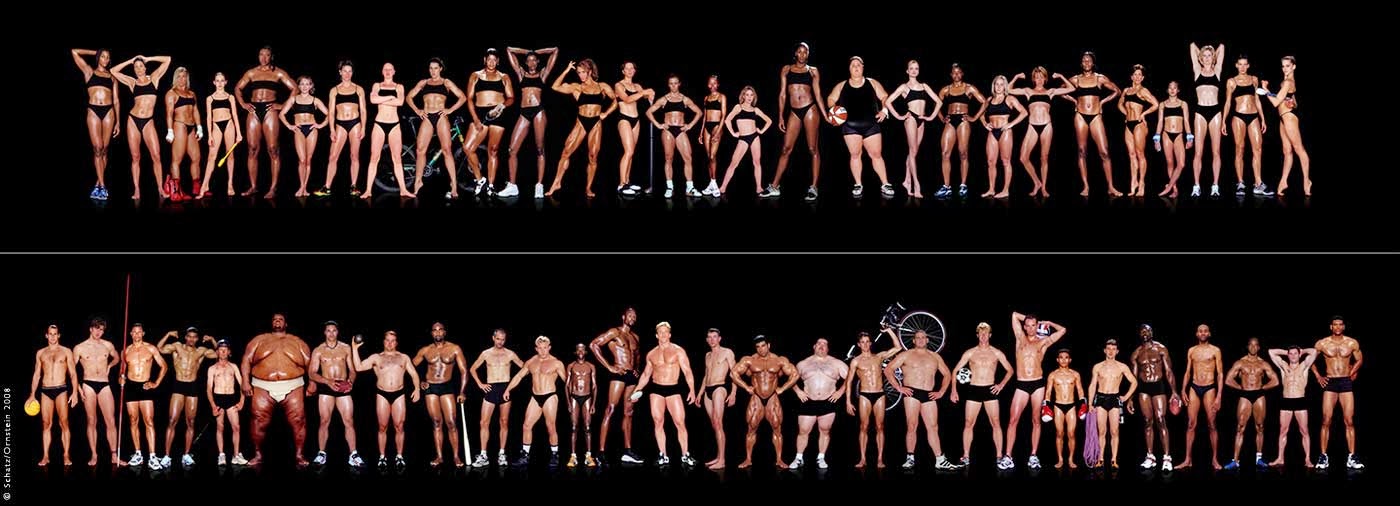While the definition of fitness in the dictionary is set, we all have different ways how we understand it but regardless of our personal differences, we commonly associate the following qualities with fitness:
- low body fat %
- high muscle to fat ratio
- sustainable high energy levels
- good health
- injury free
- being sexy and find high quality partners for mating
- happiness derived from all of the above.
What makes an athlete fit?
Almost everybody wants to be fit but have you ever questioned and made clear what it means to be fit? Fitness is not only about the body fat percentage and muscle building. I personally dislike to see all the pictures of “fit” people posted on social media. Sure, they are visually appealing but anytime people speak in general terms about athleticism and competitions, they mean body builders and body building competitions as if it was the only sport.
Body follows function and you can see different body types of fit athletes across different sports pictured below.
Besides that, what is it that makes us fit? Mr. Bielik mentioned several things. To paraphrase him, when we participate in sports regularly, we might consider ourselves fit. We consider elite athletes who train 20-40 hours a week, fit. But those athletes fight with low energy levels, in better cases only outside of training sessions, have low libido, they get injured or ill.
By his definition, a fit athlete has a strong immune system, is energetic, healthy, and I might add – enjoys his or her life in and outside of the sport. Expanding the picture beyond the physical fitness alone.
The Fitness Level Seems to be Decreasing
At the same time, it seems like our fitness levels are decreasing from generation to (de)generation.
When we look at the statistics mentioned in the study by Jens Jakob Andersen and assisted by Ivanka Andreeva Nikolova, several facts stand out as the study concluded.
- The average American runner have never been slower (across gender and distance);
- This effect is not due to the increase of female participants or “runners” – people who run slowly or walk the race;
- Signs of poor health are highly correlated to the decrease in speed. Though we cannot with certainty say that these are the causes for the slowdown. And if they have causal nature that they show the full picture.
We can find similar trends in different countries outside of the U.S.
Mr. Bielik did a similar study in Slovakia, where the results were staggering, confirming the results of the study mentioned above. As we already know, the problem is not that there are more, casual participants competing in marathons, although numbers are increasing dramatically year by year. Neither it is the higher percentage of women, who typically have slower times. We need to expand the picture and look at the population and how our lifestyle changed over time.
The Exercise Paradox
Year to year, we are getting more and more sedentary and we also compensate it by sport activities. But do we, really?
To present my argument, let me ask you a question. If you run an hour each day (or exercise on general), it makes seven hours a week. That is a pretty nice number but let’s take into consideration that a day has 24 hours and a week has 168 hours. Do you think that 7 out of 168 is enough? Do you think that 20 would be enough?
Compared to previous generations, we are getting more active exercise-wise, yet we less active overall. You simply cannot substitute four or five hours of activity, even if easy, during a day for a sedentary lifestyle partly compensated by an hour of exercise, however intense.
A good example could be my personal experience from 2016 when I run my first Spartan Race. In training for the Winter Beast I run three to four times a week adding up to 20 km a week. It is not much, especially when I compare it to people (or myself nowadays) who train for running competitions or OCRs. Yet I placed 36th overall. I believe that my lifestyle made the biggest impact. At the time I used to walk about 10km (5mi) a day, something that many people don’t get done. This observation led me to my current goal of having the base of walking daily and do any other training on top of that.
People used to be very active 20 years ago. Less technology allowed them and required them to be. Even 15 years ago, when I was 12, I spent most of the time on my feet running, walking, cycling with friends.
How to reach the peak fitness
The question is how can we get fitter and even reach our peak fitness? There is a difference in tools and times a professional athlete has at his or her disposal compared to a hobby level athlete. The good news is that the principles I am going to outline apply to any level. The rest depends on the time you can invest.
I would define fitness as your capacity to exercise and recover from the given exercise day to day. If you exercise more than you can recover from, you will lose your motivation and de-train yourself over a period of time.
On top of that, you want to be able to enjoy your life outside of exercise with your significant other, friends and family. You don’t want to be a zombie unable to satisfy intimate relationships and your boss at work, which could even get you fired in the worst case.
There are two essential parts to recovery:
- Active recovery (recovery run, yoga, massages…)
- Passive recovery (nutrition, socializing with friends…)
Active Recovery
Why do we do recovery runs the day after hard workouts? To remove the metabolites and lactate from the blood-strean? Mr. Bielik during his presentation suggested that this is a myth at best. The next day, your muscles are not flooded with lactate anymore.
The true reason for an active recovery is brain stimulation. When our mind gets bored or when we are tired, we act as zombies. But when we start being active, even when tired, suddenly we get energetic. You might have noticed a similar trend during an activity that is long and monotonous like long bike rides and long runs. It also explains why doing these training in groups or in nature is more enjoyable for us – brain stimulation.
However, when it comes to active recovery, we should be aware of their adverse effects. For example, exercise produces acute inflammation in body. Had we removed the inflammation, we would not adapt to the stimulus. Thus, the popular foam-rolling in excess can impair our body’s ability to adapt. Roll once or twice a week but the best bang for your buck is a quality sleep!
Other strategies that athletes use such as cold baths or foam rolling can be good when used sparingly, if they provide any effect at all. However, the crucial point is that you don’t want to use them in excess either.
Passive Recovery
When we are active, we get energy from the CNS stimulation. However, we also need to support our activities and recovery with a good nutrition.
Nutrition is the part many people get wrong because they are confused about it. Personally I liked when Viktor Bielik, brought up this topic.

The performance nutrition
One of the essential points was that we don’t need to eat meat as much as we do. Two or three meals that include meat a week are more than enough and I could not agree more! Completely removing meat from your diet doesn’t prevent you from performing well either.
When you follow the evidence, you will find out that we require much more plant-based nutrition than animal sources of food. While dairy products and meat provide some nutrition and you don’t have to exclude them completely, more and more sources advise to minimize these sources to 10-20% of the calories.
The main benefits for athletes that come with plant-based nutrition lies in the micro-nutrient content of these foods together with their anti-oxidant content, while animal sources of food are usually easier to absorb. Fully plant-based athletes can use strategies such as sprouting, soaking, pressure-cooking to get the most of the plant sources.
One of the most important macro-nutrients, fiber, has been taking increasing amount of attention of scientist and general public as well. We cannot digest it but it serves as a nutrition for our good bacteria in intestines. If you’ve been following me, I have been posting on the social media on this topic as well as many experts in the field.
Here are the most important nutrition principles to follow:
- Eat a whole food plant-based diet.
- When possible, prefer produce from local sources. They provide much more nutrition and you help to preserve animal and plant species that could otherwise go extinct as genetically modified plants and animals are preferred in mass production for higher yield. (there are many other benefits that I will focus on in the future).
- When buying meat, go for the local sources as well. Animals raised for meat have typically a very short lifespan, which means they don’t develop, just like plants.
Conclusion
Athletes often put all their energy into exercise while not looking at the big picture of things. At the same time, hobby athletes tend to focus on what is trendy. New recovery strategies, new diet trends (keto, Atkins, paleo, vegan, gluten-free…), and exercise protocols. These things are usually so niche, they provide very little benefit if any at all(just like in the case of popular ice baths that don’t work or can be contra-productive). We should focus on time-proven strategies and use a common-sense filter together with critical thinking.
Infographic: https://runrepeat.com/american-runners-have-never-been-slower-mega-study
Title image by: Bradley Wentzel

